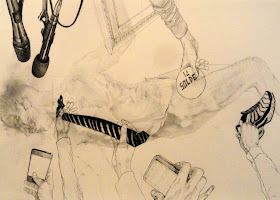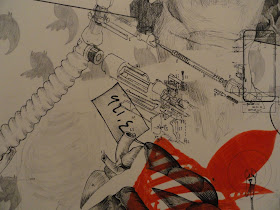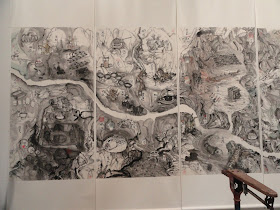Nidhal Chamekh
Nidhal Chamekh had two distinctly different bodies of
work on show. The first was perhaps more traditional, and consisted of a series
of approximately A2 size drawings, hung framed in 2 rows. The drawings were
fragmented images, sometimes using biro and at other times more traditional
‘art’ media. They also included Arabic script. He is obviously interested in
science and its ‘objective’ status, the drawing often using engineering cross
sections or biological illustration, off set against more emotive subject
matter. Chamekh grew up in Tunis, and his family were involved in militant
action, so he would have experienced the chaos of war from an early age. It has been said about his work that it works
as,“ a ‘sampler’ of
the chaos of history”. He uses montage techniques to construct his images, but has
a really good sense of design, so that as he builds these images they are still
readable and not too confused. Often hand drawn, rather than actually collaged, but combined with the use of transfer techniques (see) his
imagery relies on a basic recognition of the artist’s rendering skill as a
metaphor for ‘care’ and ‘attention’
Nidhal Chamekh
Like several other
artists at Venice Chamekh also uses models to visualize his ideas
and his second exhibit was an installation of drawings placed next to a model
of a city that had a rolling ball on a track that ran over the buildings below.
This time the drawings were all focused on ideas of time. He is obviously trying
to deal with the significance of the stopped clock. Time arrested suggesting
that moment when we take stock, or a period when we await a dramatic happening,
time seeming to stand still just before a tragic event.
Nidhal Chamekh
It was also good to see the drawings of William
Kentridge again. Another artist who has often responded to political events in
his past work, this time however he was looking back into history and the way
that wars and the victims of war are a long running theme in art history. He was
asked to respond to being part of the Italian pavilion and took the opportunity
to revisit old images of Italian martial history, reminding us of the ever constant violence
that seems to pervade human history. I was particularly interested in the way
he worked from existing imagery and made it his own through his particular use of
expressive charcoal and ink drawings.
This was a very large ink and brush drawing, covering several sheets of paper.
One ink drawing in particular (see above) had been enlarged and then cut out, (I presume laser-cut), it was then hung and mounted against a brick wall. I didn’t think it really added to its effect, but it was interesting technically.
William Kentridge
Finally a reminder that you can always be on the
lookout for new ways of presenting drawings. Terry Adkins had had a series of
drawings/prints displayed using a hinged rack. It looked as if it was designed
for a commercial outlet, and added a ‘consumerist’ message to his images
because of this.
Terry Adkins
I could continue to put up posts on Venice, but
perhaps this is enough for now. I am aware that some of you may well be going
there this coming semester, if you do, try and use the experience to think about
your own work’s ambition and where you perhaps stand in relation to the
possibility of making work that has a political or moral dimension. This is not
to say it has to, but simply one of those experiences that can help you when
positioning your practice. It may also be a useful experience even if you
hate the work on show, this can be a very powerful indicator that you either
need to confront these issues or that your work should be non political
and if this is the case you will be in agreement with some of the most revered thinkers
in aesthetics. Kant’s ‘disinterested interest’ pointing to a position in
aesthetics whereby the artist’s job is not to comment on the world or try to change it but to
observe it and the way it operates.
See also:
2022
Venice Biennale 2022 Part three
Venice Biennale 2022 Part four
2019























































